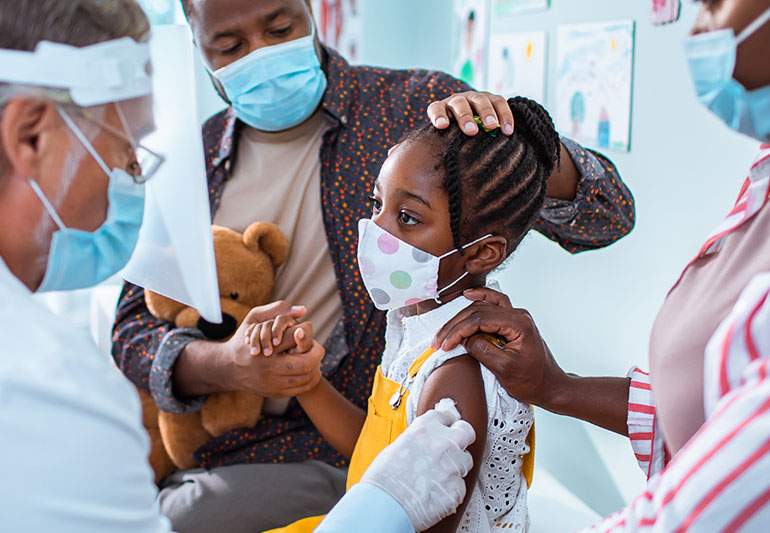
On May 5, 2021, Canada became the first country in the world to approve COVID-19 vaccine for emergency use in children aged 12–15 years; later the same month, the US Food and Drug Administration and European Medicines Agency also gave the green light to the Pfizer-BioNTech COVID-19 vaccine for adolescents. Children younger than 12 years are the next population who need a safe and efficient COVID-19 vaccine. In The Lancet Infectious Diseases, Bihua Han and colleagues reported the results of a double-blind, randomised, controlled, phase 1/2 clinical trial, which showed that the inactivated COVID-19 vaccine (CoronaVac) had good safety, tolerability, and immunogenicity in youths aged 3–17 years. This promising result should inspire the ongoing trial of other COVID-19 vaccines in children younger than 12 years. Children contributed 14·1% of the total COVID-19 cases in the USA. In children, COVID-19 is usually mild and often asymptomatic. However, in rare cases, children can become seriously ill and need hospitalisation and intensive care. One of the possible adverse outcomes has been termed multisystem inflammatory syndrome in children (MIS-C); children with MIS-C have fever and become severely inflamed, and develop multisystem disorders involving the heart, lungs, kidneys, brain, skin, eyes, and gastrointestinal tract. The overall mortality of MIS-C is approximately 1–2%. Evidence has shown an association between COVID-19 and MIS-C occurrence.
These adverse outcomes of COVID-19 in children justified the necessity to vaccinate children against COVID-19, as the BNT162b2 vaccine has shown 100% efficacy in children aged 12–15 years.
Herd immunity against COVID-19 is the prerequisite to end this pandemic, either through vaccinations or natural infection. Most estimates placed the threshold at 65–70% of the population gaining immunity, mainly by vaccination. However, widely circulating virus variants and persistent vaccine hesitancy make this threshold difficult to reach. A worldwide survey showed only 54% of respondents reported that they would definitely have a COVID-19 vaccination if it were available. In addition, novel variants with increased transmissibility and enhanced immune-evasion changed the herd-immunity equation. Thus, the calculation has to be revised upwards and children must be covered in the immunisation campaign. Moreover, from an epidemiological perspective, if we leave children unvaccinated when adults achieve immune protection, we cannot exclude the possibility that unvaccinated children become the virus shelter, given that most COVID-19 cases in children are mild and asymptomatic. The inactivated vaccine in Han’s trial induced higher titres of neutralising antibodies compared with adults aged 18–59 years who received the same vaccine; the Pfizer-BioNTech vaccine showed a similar trend: vaccinees developed higher titres of neutralising antibodies in children aged 12–15 years than in those aged 16–25-years. Children’s strong response means that they are more likely to develop immune overactions than adults, such as fever and allergy, so COVID-19 vaccine for children should balance a protective immune response and side-effects. For the inactivated vaccine, CoronaVac, the 3 μg dose induced higher titres of neutralising antibodies than the 1·5 μg dose, whereas it showed no significant difference in side-effects between the two doses, so 3 μg doses were used for phase 3 trials in children. But for other vaccines, such as the mRNA and viral vector vaccines, lowering the vaccination dose used in adults should be considered in the clinical trial for children. The safety and efficacy of COVID-19 vaccine in adults cannot guarantee the same performance in children. COVID-19 illness in adults post-vaccination was identified by onset of symptoms of acute respiratory illness; whereas in children, most COVID-19 cases are mild and asymptomatic, and parents might not be aware of the infection since children get sick more frequently than adults (such as with common colds), which would make the infection rate underestimated and efficacy overestimated. Moreover, children younger than 12 years are at their key stage of growth and development; caution should be taken to evaluate the long-term effect of vaccine on children’s development. Although vaccinating children is essential to reach herd immunity and limit the severity of COVID-19, safety should be the paramount factor to be considered before COVID-19 vaccine can be rolled out in younger children. Given the distinct immunogenicity profile and development stage of children, post-marketing surveillance of the vaccine safety should be done and maintained for a longer period than that in adults.